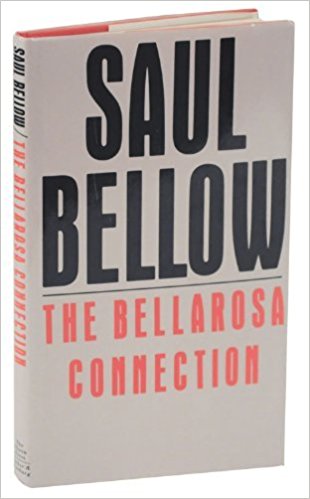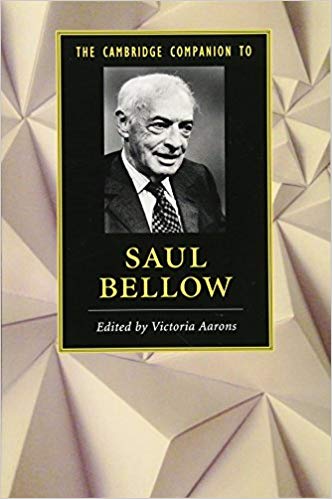tutorial, commentary, study resources, and web links
The Bellarosa Connection (1989) is a novella in which Saul Bellow examines three aspects of what he calls ‘Jewish history’ – and to which might be added the epithet ‘Jewish immigrant history’. It’s also the first major piece of his fiction in which he addresses the issue of the Holocaust. As he said of this topic in an interview, commenting on the absence of these topics in his earlier work:
Somehow I managed to miss the significance of some very great events. I didn’t take hold of them as I now see I might have done. Not until The Bellarosa Connection. So I have lived long enough to satisfy a few neglected demands.
In this novel (or novella) he looks at the plight of the Jews in Europe who in the twentieth century have been persecuted first by the Russians (and others) and then by the Germans. Many of them emigrated to America, where he examines two generations. The first was glad to escape persecution and worked hard to establish a new life. The second generation grew up as naturalised Americans, but they had a family background, a cultural tradition, and a ‘history’. They could either ignore this and become ‘Americanised’ or take on the burden of their social inheritance.
The Bellarosa Connection – critical comment
Literature and history
Whilst the characters in the novel are fictional constructs, Billy Rose was a real-life historical person. He was a famous theatrical impresario and a showman who amassed a huge personal fortune and founded a sculpture garden in Jerusalem. He also wrote the lyrics to popular songs such as Me and My Shadow and It’s Only a Paper Moon. However, suspicions exist that he paid ghost writers to do most of the work – a rumour that Bellow incorporates into the novella.
The rescue operation bearing his name is a fictional transposition of the fact that Billy Rose did become involved in organising fund-raising events in America for the aid of European Jews. Thus Saul Bellow is mingling fact and fiction here – in a way which became quite fashionable in post second world war American fiction.
The reader is being asked to ‘suspend disbelief’ – that is, to simultaneously accept information from a historical and an invented source. Questions arise such as “Did this really happen?” and “Is this really true?” and such doubts must be dealt with as a matter of aesthetic judgement by the reader. We ask ourselves – Are these events plausible? Do they make sense? Is the author pushing invention too far here?
We are being invited to accept the simultaneous existence of Billy Rose, a real-life historical figure whose biographical details can be looked up in Wikipedia, and the Fonsteins who are fictional constructs (even if they were based on people who Bellow knew personally).
The narrator
The reader’s dilemma in making these judgements is perhaps made easier by the sheer drive and panache of Bellow’s first person narrator. In most of his novels from Augie March onward he employs narrators who are clear substitutes for Bellow himself as a sophisticated intellectual with an enormous grasp of cultural history. He develops narrators who are witty, well-informed, and very entertaining. The result is that as readers we tend to believe what they are saying, even though we know they are fictional constructs.
He also employs a style of narration which is a fascinating admixture of street language, colloquial expressions, slang, and the vocabulary of intellectual and even philosophic discourse.
I was at the bar of parental judgement again, charged with American puerility. When would I shape up, at last! At the age of thirty-two, I still behaved like a twelve-year-old, hanging out in Greenwich Village, immature, drifting, a layabout, shacking up with Bennington girls, a foolish intellectual gossip, nothing in his head but froth—the founder, said my father with comic bewilderment, of the Mnemosyne Institute, about as profitable as it was pronounceable
What’s more, this narrative voice was consciously developed, and is a reflection of Bellow’s desire to fuse Eurocentric culture absorbed via his higher education with the American demotic in which he had been raised as the son of first-generation immigrants:
What I found was the relief of turning away from mandarin English and putting my own accents into the language My earlier books had been straight and respectable. As if I had to satisfy the demands of H. W. Fowler. But in Augie March I wanted to invent a new sort of American sentence. Something like a fusion of colloquialism and elegance … Street language combined with a high style.
Americanisation
Bellow sees the question of Jewish history in three phases. First is the flight of parents from anti-Semitism and poverty in Europe. Second is immigration and establishing an economic foothold in America. The third phase for their children is a choice between their Jewish heritage or assimilating as Americans. As his narrator makes quite clear:
“But if you want my basic view, here it is: The Jews could survive everything that Europe threw at them. I mean the lucky remnant. But now comes the next test—America. Can they hold their ground, or will the U.S.A. be too much for them?”
Immigration and race
In connection with the issue of race and American society,
as has been argued in a similar analysis of his late novel Ravelstein, it is slightly surprising that at no time does Bellow consider the subject of African-Americans who were also ‘immigrants’. They however were imported against their will into a protestant God-fearing society which then exploited and persecuted them.
Bellow is not obliged to cover every racial issue in the flux of American life, but the close parallels between European Jewish immigrants (fleeing from persecution) and Africans (imprisoned in a slave culture) did not seem to occur to him as a fruitful point of comparison. Bellow is very conscious of modern history, but the fact is that the Africans were made forcible ‘immigrants’ to American society from the sixteenth century onwards, whereas the Jewish diaspora affected America largely from the late nineteenth century.
The Bellarosa Connection – study resources
![]() The Bellarosa Connection – Penguin – Amazon UK
The Bellarosa Connection – Penguin – Amazon UK
![]() The Bellarosa Connection – Penguin – Amazon US
The Bellarosa Connection – Penguin – Amazon US
![]() The Bellarosa Connection – Library of America – Amazon UK
The Bellarosa Connection – Library of America – Amazon UK
![]() The Bellarosa Connection – Library of America – Amazon US
The Bellarosa Connection – Library of America – Amazon US
![]() Saul Bellow – Collected Stories – Penguin Classics – Amazon UK
Saul Bellow – Collected Stories – Penguin Classics – Amazon UK
![]() Saul; Bellow – Collected Stories – Penguin Classics – Amazon US
Saul; Bellow – Collected Stories – Penguin Classics – Amazon US
![]() Saul Bellow (Modern Critical Views) – essays and studies – Amz UK
Saul Bellow (Modern Critical Views) – essays and studies – Amz UK
![]() Saul Bellow (Modern Critical Views) – essays and studies – Amz US
Saul Bellow (Modern Critical Views) – essays and studies – Amz US
Cambridge Companion to Saul Bellow – Amazon UK
The Bellarosa Connection – plot summary
A successful and un-named academic specialises in memory studies. He wishes to record a history of emotions and states of being, conscious of his poor Jewish immigrant background. He recalls the story of his relative Harry Fonstein who escapes Hitler and flees to Italy where he works as a waiter in Rome.
Fonstein is arrested at a fascist reception and jailed, but then his escape is arranged by a clandestine operation organised by Billy Rose (‘Bellarosa’). Rose is a flamboyant theatrical impresario and newspaper gossip columnist who collects fine art and has made a fortune from show business. He keeps his rescue operation secret and will not even meet the people he saves. The narrator assumes that the Mafia are also involved in his operations.
Fonstein escapes to America where he is detained on Ellis Island. From there he is exported to Cuba, and forbidden to mention Billy Rose. In Cuba he works as an assistant and educates himself through part-time study.
A marriage is arranged with an overweight woman from America, which gives him naturalisation papers. He moves to New Jersey where he becomes successful running a plumbing supplies business. When he tries to thank Billy Rose for saving his life, all his overtures are rejected..
The narrator discusses ‘Jewish history’ with Fonstein’s obese wife Sorella, but finds the Nazi horrors ‘burdensome’. He then meets the Fonsteins on holiday in Israel, where Billy Rose is staying at the same hotel. Sorella reveals that Rose’s assistant kept a secret journal and papers documenting all Rose’s personal foibles and shady business deals. The narrator declines the offer of seeing the documents.
Sorella arranges a meeting with Billy Rose and uses the documents as blackmail in an attempt to persuade Rose to give her husband a brief audience. Rose vigorously defends his reputation and refuses her request. She throws the documents at him – but they go out of the window..
Some years later the narrator is asked for Fonstein’s contact details by a Rabbi who is seeking help for an insane man who claims to be a relative of Fonstein. The narrator makes phone calls to people who might know – and gets short shift from them.
When he finally locates the address, a young man is house-sitting. He reveals that the Fonsteins were killed in a motor accident six months earlier. They were on their way to their mathematically gifted son who had taken up gambling and was in trouble.
© Roy Johnson 2017
More on Saul Bellow
More on the novella
More on short stories
Twentieth century literature
>

